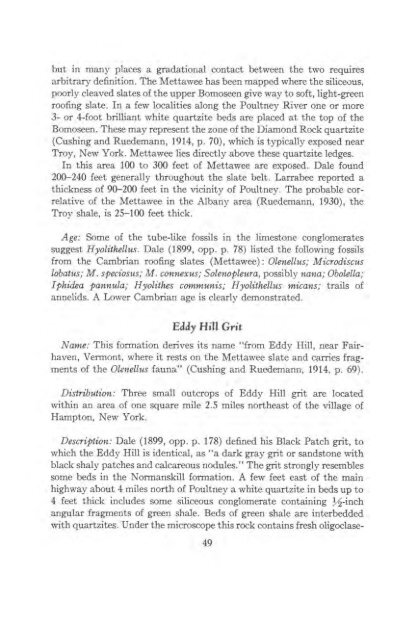STRATIGRAPHY AND STRUCTURE CASTLETON AREA VERMONT
STRATIGRAPHY AND STRUCTURE CASTLETON AREA VERMONT
STRATIGRAPHY AND STRUCTURE CASTLETON AREA VERMONT
You also want an ePaper? Increase the reach of your titles
YUMPU automatically turns print PDFs into web optimized ePapers that Google loves.
ut in many places a gradational contact between the two requires<br />
arbitrary definition. The Mettawee has been mapped where the siliceous,<br />
poorly cleaved slates of the upper Bomoseen give way to soft, light-green<br />
roofing slate. In a few localities along the Poultney River one or more<br />
3- or 4-foot brilliant white quartzite beds are placed at the top of the<br />
Bomoseen. These may represent the zone of the Diamond Rock quartzite<br />
(Cushing and Ruedemann, 1914, p. 70), which is typically exposed near<br />
Troy, New York. Mettawee lies directly above these quartzite ledges.<br />
In this area 100 to 300 feet of Mettawee are exposed. Dale found<br />
200-240 feet generally throughout the slate belt. Larrabee reported a<br />
thickness of 90-200 feet in the vicinity of Poultney. The probable correlative<br />
of the Mettawee in the Albany area (Ruedemann, 1930), the<br />
Troy shale, is 25-100 feet thick.<br />
Age: Some of the tube-like fossils in the limestone conglomerates<br />
suggest Hyolithellus. Dale (1899, opp. p. 78) listed the following fossils<br />
from the Cambrian roofing slates (Mettawee): Olenellus; Microdiscus<br />
lobatus; M. speciosus; M. connexus; Soleno pleura, possibly nana; Obolella;<br />
Ipijidea pannula; Hyolithes communis; Hyolithellus micans; trails of<br />
annelids. A Lower Cambrian age is clearly demonstrated.<br />
Eddy Hill Grit<br />
Name: This formation derives its name "from Eddy Hill, near Fairhaven,<br />
Vermont, where it rests on the Mettawee slate and carries fragments<br />
of the Olenellus fauna" (Cushing and Ruedemann, 1914, p. 69).<br />
Distribution: Three small outcrops of Eddy Hill grit are located<br />
within an area of one square mile 2.5 miles northeast of the village of<br />
Hampton, New York.<br />
Description: Dale (1899, opp. p. 178) defined his Black Patch grit, to<br />
which the Eddy Hill is identical, as "a dark gray grit or sandstone with<br />
black shaly patches and calcareous nodules." The grit strongly resembles<br />
some beds in the Normanskill formation. A few feet east of the main<br />
highway about 4 miles north of Poultney a white quartzite in beds up to<br />
4 feet thick includes some siliceous conglomerate containing h-inch<br />
angular fragments of green shale. Beds of green shale are interbedded<br />
with quartzites. Under the microscope this rock contains fresh oligoclase-<br />
49













